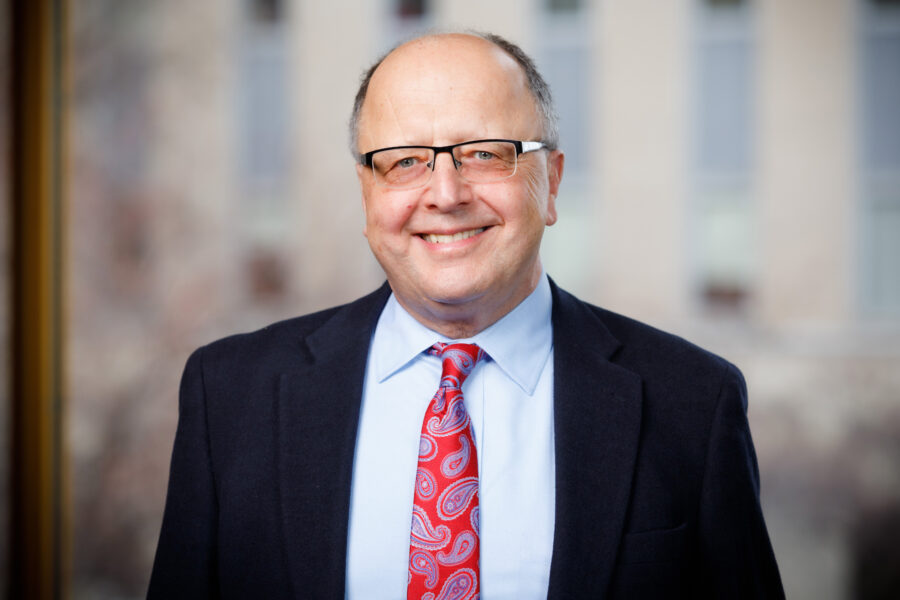A dramatic shift in the treatment of large ischemic stroke was announced today, Feb. 10, at the 2023 International Stroke Conference held in Dallas.
“It’s a watershed moment in stroke treatment,” said Pierre Fayad, MD.
Dr. Fayad was invited by the New England Journal of Medicine to write an editorial about the publication of two clinical trials being presented at the conference by other researchers.
Dr. Fayad is the medical director of the Nebraska Stroke Center at Nebraska Medicine and chief of the vascular neurology and stroke division in the department of neurological sciences at UNMC.
He did not participate in the research but was asked by NEJM to give his assessment as an internationally recognized expert in stroke therapy.
His assessment was based on the impact from the results of two randomized clinical trials conducted by researchers in six different countries, including the United States, involving more than 800 patients that conclusively demonstrate the successful impact of endovascular therapy at improving outcomes in acute stroke with a large ischemic region caused by a blocked large blood brain vessel.
The findings of those studies, along with the editorial written by Dr. Fayad, were published simultaneously online in the New England Journal of Medicine today, to coincide with the public presentation of the study results at the conference.
“Together, these trials, in addition to previous studies, provide reassuring information from over a thousand patients with large acute ischemic strokes in different medical systems that will probably lead to changes in patterns of care delivery,” Dr. Fayad said.
The consequences of a stroke can be catastrophic and lead to lasting brain damage, severe disability or even death.
Every year, nearly 800,000 people in the U.S. alone are impacted by stroke, according to the Centers for Disease Control and Prevention, and 87% of those are ischemic – or clot related – strokes.
Since 1995, t-PA (recombinant tissue plasminogen activator) drug therapy, better known as the clot busting drug, became the first treatment to reverse the damage from ischemic stroke when administered intravenously for up to 4 ½ hours from the onset of symptoms. The effects are modest, as the blockage in the blood vessels is resolved in 20% to 30% of patients.
Another watershed event in stroke treatment occurred in 2016-2018, when several U.S. and international trials showed that endovascular mechanical thrombectomy therapy successfully removes the blood vessel blockage causing a small to moderate size stroke for up to 24 hours with small risks of brain bleeding or swelling, and dramatically improved patient outcomes in terms of mobility and disability.
“The results were stunning,” Dr. Fayad said. “Mechanical thrombectomy opened up the blood vessels in 70 to 80% of patients and became one of the most effective treatments in medicine. Mechanical thrombectomy prevents disability in one patient for every two to three patients treated.”
Researchers then began to look into using endovascular therapy to treat large strokes that impact a larger area of the brain and represent 20% of strokes with proximal large blood vessel occlusion.
Since such patients were excluded from the studies above, the benefits and risks of thrombectomy remained unknown, and therefore these patients are not currently treated in clinical settings.
A study published last year by researchers in Japan proved this same method also was effective in removing blood vessel blockages, in 202 patients with large ischemic strokes with minimal risks while improving patient outcomes. The results, however, did not change practice, as the study was done exclusively in Japanese patients, where the TPA dose is lower and MRI was exclusively used.
Two other trials, one done internationally in the U.S., Canada, Europe, Australia and New Zealand and the other one done exclusively in China, were halted after the results of the Japanese trial became public, prompting a review of the data that showed remarkably similar results to the Japanese trial overall, Dr. Fayad said.
The benefits of endovascular thrombectomy were consistent across age, degree of neurologic deficit, imaging characteristics and time of treatment for up to 24 hours after the onset of symptoms, regardless of geographic location among patients enrolled in the trials.
Although the outcomes were improved overall, the risk of death was unchanged, but severe disability was improved to moderate disability, with more functional capabilities, including the ability to walk independently. Modest increases in risks of bleeding, brain swelling and local catheter-related complications also were noted in the trials, without significantly affecting the positive results.
Now that the results from more than 1,000 patients studied are public, clinicians at comprehensive stroke centers such as Nebraska Medicine, backed by the evidence, can more comfortably offer the treatment to patients suffering from large ischemic strokes, Dr. Fayad said.
“The improved chance of independent walking and the ability to perform other daily activities in patients with the most severe strokes is welcome news for patients and for the field of stroke treatment,” he said.

Thanks for providing clarity on this breakthrough, Dr. Fayad. UNMC is lucky to have you on our team.
Congratulation Dr. Fayad!
Thank you for providing your perspective on the changing evidence across the timeline and how we adopted.